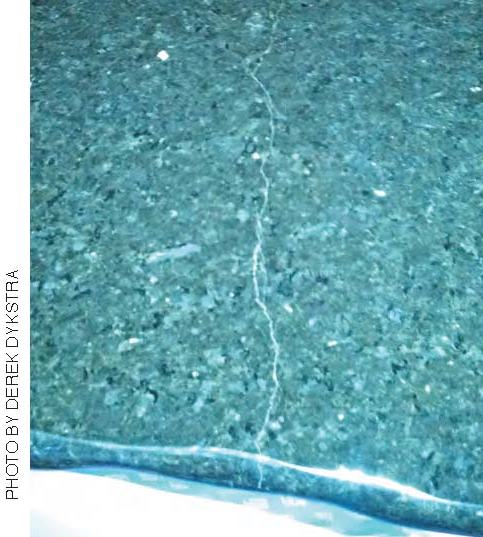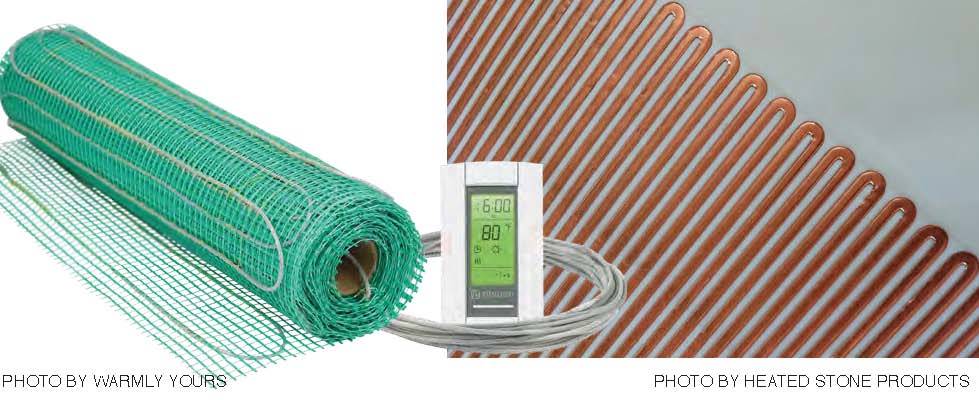Countertops Magazine ArchiveHeated CountertopsAvoiding Potential Pitfalls in Heating High-end Surfacing There are numerous reasons homeowners have adopted heated flooring in bathrooms, basements and even kitchens as one of the thermal comforts of higher-end homes. Particularly in colder climates, some people cringe at the thought of placing bare feet on cold tile during the winter and liken heated flooring to the feel of slipping into a warm bed. Technologies are now available for heating tile, stone or even engineered and hardwood floors. However, that idea is now leaping from the floor to the countertop in high-end settings. In many luxury homes, stone (whether natural or engineered) is the countertop material of choice. That said, the surface characteristics of stone make it a poor thermal conductor, which can make countertops feel cold to the touch, even though they may actually be at room temperature. However, heating a stone countertop isn’t as simple as just converting a floor heating system, but technology has now advanced to take on the long-standing issue of reliably eliminating the cold feel of stone countertops without introducing a risk of cracking the stone. Causes of Cracking Because of the thermal properties of stone, heating a stone countertop can present a challenge. The largest concern is introducing thermal shock to the stone which can crack the countertop. Because stone countertops are a significant investment, particularly in luxury settings, the financial risk to the fabricator or installer is significant, not only in loss of profit, but in damage to his or her reputation as well as the impact to the specific customer’s project. Heat-induced cracking of countertops occurs because of the molecular properties of stone (natural or man-made varieties). All materials experience expansion/contraction when subjected to temperature variations. Scientists utilize a method of measuring this physical change called CTE – Coefficient of Thermal Expansion. Low thermal expansion indexes indicate materials that have low physical change across at thermal range (see Figure 1). CTE of Common Materials
Figure 1 Source: The Engineering Toolbox When stone is subjected to heat, for every degree F of temperature rise, the stone expands a minute level. Cracking occurs when the differential of expansion between hot and cold zones within the stone is too severe, introducing thermal stress within the stone either vertically (between layers within the stone’s thickness) or horizontally (side-by-side hot/cold areas). When the thermal stress becomes too high, it overcomes the stone’s ability to hold itself together and a crack develops. Additionally, cracks can be formed when the thermal stress of heat differential is repeated time and time again, weakening the stone’s ability to overcome the stresses. To specifically address stone cracking risks, the following items should be incorporated into the heating scheme:
Methods of Heating In the past, fabricators/installers have used various methods to heat countertops on a sporadic project-by-project basis. Forced air heating, fluid-based tube heating and electric resistive floor heating mats have been used in the past with modest results. These technologies have been developed for general home heating and floor heating, but they are not ideal for the specifics needs of countertop heating. One of the technical challenges in warming a countertop is that countertop stones do not radiate heat laterally within the stone. Within 1 in. of a heating element, the stone surface temperature can drop 50 percent and within 2 in., the stone may not be heated at all. Also, with countertops, it is essential that the countertop’s edges are warmed just like in the body of the counter or customers will be disappointed. Because of the poor thermal conductivity of stone, the heating element therefore needs to extend as close to the edge of the stone as possible to avoid cold edges (within ½ in. if possible). Floor heating mats, for instance, use thick round wire elements that become difficult to include in a countertop project because of their size. Also, because they are designed to heat large areas of flooring, they are powered by high voltages (household power of 120V or even 240V) in order to get the needed wattage output. Floor heating is controlled using a closed loop control scheme where a sensor provides feedback to the electronic control device on what the temperature of the floor is. The combination of higher voltage and a temperature sensing system creates pulsing of the heating element that institutes a fast heat rise followed by a delayed power off stage. This repeats continually to arrive at an average surface temperature. Unfortunately, this can lead to cracking (see Figure 2). In this example, Derek Dykstra, a custom homebuilder in California, used a floor heating system as a countertop heater. Within 24 hours of activating the heater, the stone cracked on the surface. Per Derek Dykstra, “The countertop would lie perfectly flat while cold, but once the heat was applied, the countertop would heave at its seam,” said Dykstra. “Eventually, the crack grew across the width of the slab.”
Figure 2 - The combination of higher voltage and temperature sensing systems common in floor heating systems creates pulsing of the heating element that institutes a fast heat rise followed by a delayed power off stage that repeats continually. Unfortunately, when they are used for countertop applications, this can lead to cracking. However, after repeating the identical job using a heating system specifically developed for countertop applications, there were no further problems and Dykstra now has a happy customer. But, that can be a pretty expensive lesson to learn. Risk-Free Solution Within the past year, a technical advancement of electric radiant heaters has occurred that specifically addresses the obstacles with heating countertops. Electric heating mats utilizing ultra-thin elements have become available in large-format custom shapes and sizes. Ultra-thin flexible heaters operate on low voltage and utilize flat foil as the resistive conductor instead of thick round wire (see Figure 3). These ‘etched-foil’ based heaters are laminated between thin high performance plastic films constructed of Polyimide or PET (Polyethylene Terephthalate) polymer materials to create a very rugged and dependable heating mat.
Figure 3 – (left) An example of a floor heating “roll” that is modified to fit a countertop. The large gap between elements, along with the difficulty of applying the elements close to the counter edge, introduce uneven heating on the top surface and cold edges. (right) This FeelsWarm heating element, specifically designed for countertops, has patterns with spaces of under ¼ in. to avoid uneven heating problems. The resulting heater can be as thin as 0.010-in.-thick. Etched-foil heaters are also patterned so that the conductive heating element will match the shape and size of the countertop, will come close to the edge, and will have narrow spacing between elements (around 0.025-in.gaps) (see Figure 4). These heaters can be adhered to the underside of stone countertops using pressure sensitive tape for quick installation. The flatness permits the heater to be sandwiched between the stone and the cabinet without introducing a reliability risk or without having to mill out areas to compensate for thickness. These heating pads are designed to provide very gradual heat rise by operating under low voltage (12-24 volts) and each heater is supplied with its own transformer. They are available in both custom configurations and standard sizes and shapes. Each “plug and play” heater/transformer plugs directly into a standard 120V household outlet without the need for custom wiring or an electrical contractor. The typical installation utilizes an outlet that exists inside the cabinet or under a desk. Current draw on the outlet is 0.6 to 2 amps depending upon the square footage of the heater.
Figure 4 - FeelsWarm heaters eliminate thermal stress and resulting potential to crack, and come in two formats: (left) custom configurations, and (right) “peel and stick” formats for quick application or pre-existing countertops. FeelsWarm heaters are for quick application. Looking Forward Given their elegant appearance and regal feel, few doubt that stone countertops will diminish as a mainstay in luxury homes and businesses for decades to come. Addressing the cold feel of these countertops is just another way to expand upon their luxury. Fabricators who haven’t been introduced to this application, may very well be as homes get more and more sophisticated. However, to avoid sub-par quality in feel and performance, as well as eliminate the added risk of cracking a premiere and expensive countertop surface, it is wise to look for a product specifically designed for this use when undertaking a project of this nature. Ultimately it will lead to a happier customer and a more profitable outcome. About the Author Jahn Stopperan is a senior product development engineer and business manager in low voltage electronic assemblies and devices. He has more than 25 years’ of experience in technology/product development and management at a variety of companies. He holds more than 12 patents, and is a speaker and author. For more information visit www.dginnovationsllc.com or contact Stopperan at (952) 898-9505, ext. 3 or [email protected]. |



